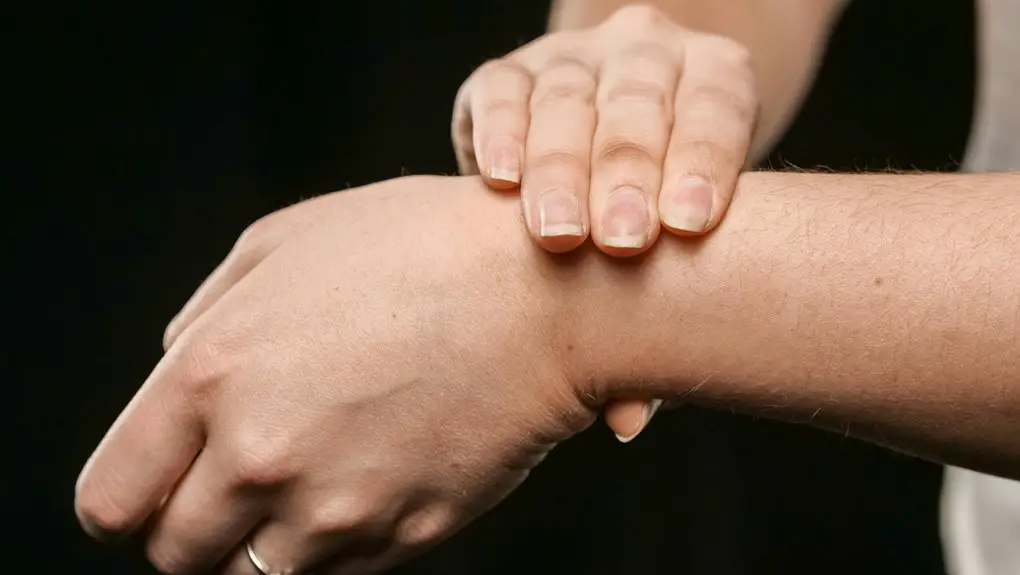Wrist rests are essential for your ergonomic comfort because they help maintain your wrists in a neutral position, reducing strain during long typing sessions. By cushioning your wrists, they relieve pressure and minimize discomfort, allowing you to focus better. Different types, like gel and memory foam, cater to your personal preferences and needs. Choosing the right one can enhance your workspace experience, which you'll discover as you explore more about ergonomic solutions.
Table of Contents
Key Takeaways
- Wrist rests maintain wrists in a neutral position, promoting better posture during typing or computer use.
- They cushion wrists, alleviating pressure and reducing pain associated with long hours of work.
- Using wrist rests minimizes discomfort, allowing for improved focus and productivity.
- They enhance stability for precise movements, crucial for accurate typing and navigation tasks.
- Incorporating wrist rests encourages healthier work habits, contributing to a more enjoyable and efficient workspace.
Understanding Ergonomics and Its Importance
Ergonomics is all about comfort and efficiency in your workspace. It focuses on designing your environment to fit your needs, rather than forcing you to adapt to it.
Understanding ergonomics helps you recognize how your posture, equipment, and workspace layout can impact your productivity and well-being. You might be surprised by how small adjustments can lead to significant improvements in your comfort and performance.
For instance, the right chair height or desk arrangement can reduce strain on your body, allowing you to work longer without fatigue.
The Benefits of Using Wrist Rests
When you spend long hours typing or using a mouse, wrist rests can provide significant relief and support.
These simple tools can enhance your comfort and productivity in several ways:
- Improved Posture: They help maintain your wrists in a neutral position, reducing strain.
- Reduced Pain: By cushioning your wrists, they alleviate pressure and minimize discomfort during extended use.
- Increased Focus: With less pain, you can concentrate better on your work without distraction.
- Enhanced Stability: Wrist rests provide a stable surface, allowing for more precise movements while typing or navigating.
Incorporating a wrist rest into your workspace can make a noticeable difference, promoting healthier habits and a more enjoyable experience.
Types of Wrist Rests Available
Finding the right wrist rest can enhance the benefits of improved posture and reduced pain.
You'll discover several types of wrist rests available to suit your needs. Gel wrist rests are popular for their soft, cushioning feel, providing comfort during long hours of typing.
Explore various wrist rests, from gel for cushioning comfort to memory foam for personalized support, perfect for long typing sessions.
Memory foam options mold to your wrist, offering personalized support that alleviates pressure points. Hard surface wrist rests are excellent for those who prefer stability and may include materials like wood or plastic.
Some wrist rests come with built-in features, like adjustable heights or cooling properties, catering to specific preferences.
Finally, consider portable wrist rests, which allow you to maintain ergonomic support wherever you go. Choose the one that fits your style and work habits best.
How to Choose the Right Wrist Rest for You
How do you determine which wrist rest is right for you? Choosing the perfect wrist rest involves considering a few key factors. Here's a quick guide to help you decide:
- Material: Opt for foam, gel, or hard surface based on your comfort preference.
- Height: Ensure it aligns with your keyboard to keep your wrists straight.
- Size: Select a width that fits your workspace and allows for easy movement.
- Weight: A heavier wrist rest won't slide around, but a lighter one may be easier to reposition.
Tips for Maintaining Proper Ergonomic Practices
While you might think that choosing the right wrist rest is all you need for comfort, maintaining proper ergonomic practices is equally crucial.
Start by adjusting your chair and desk height so your elbows are at a 90-degree angle. Keep your feet flat on the floor or on a footrest to avoid strain.
Position your monitor at eye level, about an arm's length away, to reduce neck strain. Take regular breaks to stretch and move, which helps prevent stiffness.
When typing, keep your wrists relaxed and floating above the keyboard, using your wrist rest only when not typing.
Lastly, ensure your workspace is well-lit to minimize eye strain. These simple adjustments can significantly enhance your comfort and productivity.
Frequently Asked Questions
Can Wrist Rests Help With Carpal Tunnel Syndrome?
Yes, wrist rests can help alleviate symptoms of carpal tunnel syndrome. They provide support, reducing strain on your wrists while typing or using a mouse, promoting better alignment and potentially minimizing discomfort over time.
Are There Wrist Rests Specifically Designed for Gaming?
Yes, there are wrist rests specifically designed for gaming. These rests often feature materials that enhance comfort during long sessions, providing support and reducing strain on your wrists, so you can focus on your gameplay.
How Often Should I Replace My Wrist Rest?
You should replace your wrist rest every 6 to 12 months, depending on wear and tear. Regularly check for any signs of damage or discomfort, as these can affect your gaming or typing experience significantly.
Do Wrist Rests Work With All Keyboard Types?
Wrist rests generally work with most keyboard types, but you should ensure they're compatible with your setup. Check the height and shape of your keyboard to find the best fit for your wrist support needs.
Can I Make a DIY Wrist Rest at Home?
You can definitely make a DIY wrist rest at home! Use materials like foam, wood, or even rolled towels. Just ensure it's comfortable and at the right height to support your wrists while typing or gaming.




